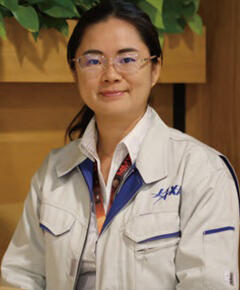
Assistant Professor at the Department of Solar System Sciences, Institute of Space and Astronautical Science, Japan Aerospace Exploration Agency/Visiting Researcher at the Biogeochemistry Research Center, Japan Agency for Marine-Earth Science and Technology.
Q1. What first sparked your interest in space?
A1. A book on extraterrestrial life that I picked up by chance.
I have loved stars since childhood and often visited planetariums and observatories with my father. I still vividly remember comets that were clearly visible to the naked eye, such as Hyakutake and Hale-Bopp. A book on extraterrestrial life that I picked up by chance at the library when I was in elementary school inspired me to become a researcher. By reading the book, I began to imagine, "what extraterrestrial life would look like if it existed," and this sparked my interest in space.
When I was in junior high school, my father bought me an astronomy magazine, and I learned about a new discipline called "astrobiology," which studies extraterrestrial life. Wanting to understand more about this field, I decided to join Nagoya University, where astrobiology research can be undertaken in Japan, and here I am today.
My current specialty, "organic astrochemistry," is the study of organic matter in the universe and its evolutionary processes, and astrobiology is an extension of this field. We believe that exploring the evolution of a series of organic molecules in the vast universe may lead to the elucidation of the origins of terrestrial and extraterrestrial life.

Q2. What is the research topic that you are currently working on?
A2. Development of analytical methods for detecting traces of life using simulated samples.
The Japan Aerospace Exploration Agency (JAXA), where I work, is currently working on the "Martian Moon eXploration (MMX)." The aim of this mission is to bring samples from Phobos, one of the Martian moons, to Earth. The spacecraft is expected to launch in 2026. I am also participating in this project and am in charge of sample analysis and "contamination control" to prevent the spacecraft from being contaminated by terrestrial materials.
Through our emerging research, we hope to establish analytical methods for detecting traces of Martian life from extremely small amounts of Martian particles, drawing on our experience in analytical chemistry. Martian particles brought back through the MMX mission and National Aeronautics and Space Administration (NASA)'s Mars Sample Return Program may contain traces of life as chemical and/or morphological signals. Methods for analyzing traces of life in such particles are being investigated globally. I am developing analytical methods that use microorganisms as a starting point.
On Earth, microorganisms on rocks take a long time to decompose. To understand the path of the microbial change, we create artificially fossilized samples of microorganisms and examine how they change under conditions that mimic the environment of the Martian moons. We hope to identify useful indicators that can be used to detect traces of Martian life. In the future, we will further investigate analytical methods for analyzing various organic molecules that make up microorganisms at the molecular level to determine organic molecules that are useful as biomarkers.

Q3. What are your goals for the future, and what is your message to future generations?
A3. Always be humble and unbiased toward nature
The number of samples that a spacecraft can bring back from extraterrestrial bodies is limited. It is always necessary to take great care to avoid contamination in the laboratory, because it is difficult to reveal the true characteristics of extraterrestrial materials if they are mixed with terrestrial ones. Nevertheless, I always look forward to "what discoveries can be made here" when dealing with new or valuable samples.
There are many things about the universe that are yet to be understood, but I personally believe that "answers can always be found in nature." It is important to remain humble toward nature and the universe and to learn from data with an unbiased perspective without preconceptions. A researcher's work is like overwriting a textbook, and it is important to have a critical perspective and ask yourself "Is this true?" In particular, an integrated perspective that is not limited by traditional academic disciplines is important in space research. Please continue to broaden your horizons and maintain a broad attitude toward learning.
(Article: Kayo Murakami)

Profile
Haruna Sugahara
Assistant Professor at the Department of Solar System Sciences, Institute of Space and Astronautical Science, Japan Aerospace Exploration Agency/Visiting Researcher at the Biogeochemistry Research Center, Japan Agency for Marine-Earth Science and Technology.
Born in Fukushima Prefecture. Completed Ph.D. in 2014 from Department of Earth and Environmental Sciences, the Graduate School of Environmental Studies, Nagoya University. Ph.D. (Science). Assumed the current position in 2019 after working as a postdoctoral researcher in the Biogeochemistry Research Center, Japan Agency for Marine-Earth Science and Technology and as a JSPS overseas research fellow at Université Côte d'Azur, France. FOREST researcher since 2021.




